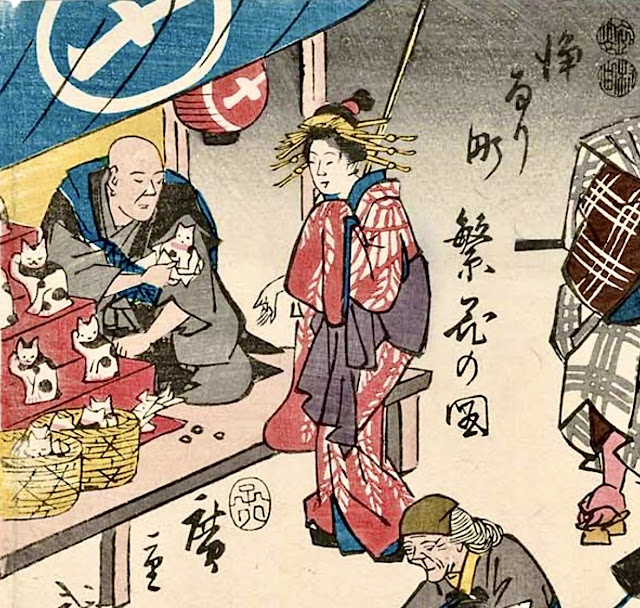Cats
The Maneki Neko
The maneki-neko is a common Japanese figurine which is often believed to bring good luck to the owner. The figurine depicts a cat, traditionally a calico Japanese Bobtail, with a paw raised in a beckoning gesture.
"Joruri-machi Hanka no zu," painted in 1852 by Utagawa Hiroshige. This picture depicts the marushime-neko, a variation of maneki-neko, being sold at Sensō-ji Temple, Tokyo.
I Am Tama, Lucky Cat - picture book by Wendy Henrichs, Yoshiko Jaeggi (Illustrator)
Cat Legends and Stories
There are various folklore in Japan about the origin of maneki-neko. Several Buddhist temples and Shinto shrines that appear in folklore, such as Gōtoku-ji, Jishōin and Imado Shrine, are known as the birthplaces of the maneki-neko.Gotoku-ji Temple
The most famous folklore concerns Ii Naotaka during the Kan'ei era (1622-1624) of the Edo period. In the story, Naotaka's party stops at Gōtoku-ji Temple to rest after being beckoned by a cat at the temple gate.
The maneki neko storey
The Boy Who Drew Cats
The story was first translated into English by Lafcadio Hearn
Courious Ordinary
The Cat's Elopement - The Pink Fairy Book by Andrew Lang and illustrated by H. J. Ford
"The Cat's Elopement" is a Japanese fairy tale collected by Professor David Brauns in Japanische Marchen und Sagen (Leipzig, 1885). Andrew Lang had it translated and included in The Pink Fairy Book (1897).
Wikisource
Japan's wildcats
The Tsushima leopard cat is one of Japan’s two wild felids, with the other being the Iriomote cat (prionailurus bengalensis iriomotensis). Both are roughly the same size as domesticated felines.
Tsushima Leopard Cat
Provided by the Iriomote Wildlife Conservation Center, Environment Ministry
Gotoku-ji Temple
Gotoku-ji is a Buddhist temple located in the Gōtokuji district of Setagaya ward, Tokyo, Japan.
Maneki neko
The Birthplace of Maneki Neko
What is the story of maneki-neko, the Japanese beckoning cat?
Cat yokia - Yokaistreet
National Geographic
Maneki Neko 招き猫 or 招猫 Lucky Beckoning Cat or Inviting Cat
The Boy Who Drew Cats
Archive
The Cat's Elopement By Andrew Lang
Archive
Wikisource
Mythology and Folklore
Librivox
The Cat's Elopement - YouTube
The Skald's Circle
Revibe
Japan's Wildcats
Tsushima Leopard Cat
Medium
Iriomote Cat
Photos
Wikipedia
Iriomote Wildlife Conservation Center
Podcast
Cat Folklore
Japan Archives - E40 - Cat Folklore #1
Website- show notes
YouTube
2









